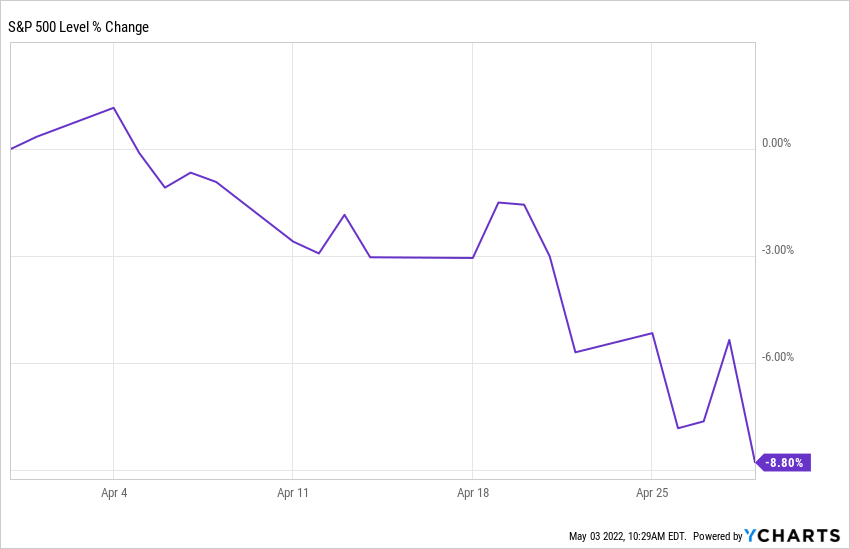Monthly Market Update
Submitted by TLWM Financial on May 3rd, 2022
April was another challenging month for investors as the S&P 500 was down almost 9%, while bonds also struggled as the Bloomberg US Aggregate Bond Index fell about 3.5% (YCharts).
We made changes to our portfolio positioning in the middle of the month in an effort to reduce risk within the growth portion of portfolios. We believe that our risk management process is a critical part of caring for you, and your money.
These changes were made because we were seeing deterioration in our dashboard, signaling an increased chance of recession moving forward. By reducing your stock market risk our goal is to try to reduce volatility in a portion of the portfolio with the hope of being able to reinvest those funds at a lower price.
Today we wanted to highlight a few things that we’ll be watching as we continue to evaluate our portfolio positioning:
- Our Economic Dashboard – a number of factors in our economic dashboard have worsened throughout the year. We’ll be watching the data closely to see if the dashboard continues its decline or whether we see improvement.
- The Fed – expectations have changed a lot for the Fed over the last 6 months. Now, most investors believe that a 50bp (0.50%) hike to the Fed Funds rate is likely in May with more hikes in the months to come (CME FedWatch Tool). The Fed’s ability to fight inflation without pushing the economy into recession is likely to be tested this year.
- Corporate Earnings – we are in the midst of Q1 earnings season. We’ll be watching earnings results closely to understand how companies have managed the challenges they’ve faced, and what they expect for the remainder of the year.
While we are positioned more defensively today our allocation is subject to change as market and economic conditions evolve. This may mean reducing risk further, or it may mean re-allocating to stocks.
Investing through volatility can be difficult, so don’t hesitate to call us with any questions and please pass along our thoughts to your friends, family, and colleagues. We want to be a resource to them.
Sincerely,
Your Team at TLWM
* Investment advice offered through TLWM, LLC., a registered investment advisor.
* The Standard & Poor's 500 (S&P 500) is an unmanaged group of securities considered to be representative of the stock market in general. You cannot invest directly in this index.
* The Standard & Poor’s 500 (S&P 500) is an unmanaged index. Unmanaged index returns do not reflect fees, expenses, or sales charges. Index performance is not indicative of the performance of any investment.
* The 10-year Treasury Note represents debt owed by the United States Treasury to the public. Since the U.S. Government is seen as a risk-free borrower, investors use the 10-year Treasury Note as a benchmark for the long-term bond market.
* Government bonds and Treasury Bills are guaranteed by the U.S. government as to the timely payment of principal and interest and, if held to maturity, offer a fixed rate of return and fixed principal value. However, the value of fund shares is not guaranteed and will fluctuate.
* Corporate bonds are considered higher risk than government bonds but normally offer a higher yield and are subject to market, interest rate and credit risk as well as additional risks based on the quality of issuer coupon rate, price, yield, maturity, and redemption features.
*Credit risk can be a factor in situations where an investment’s performance relies on a borrower’s repayment of borrowed funds. With credit risk, an investor can experience a loss or unfavorable performance if a borrower does not repay the borrowed funds as expected or required. Investment holdings that involve forms of indebtedness (i.e. borrowed funds) are subject to credit risk.
* Typically, the values of fixed-income securities change inversely with prevailing interest rates. Therefore, a fundamental risk of fixed-income securities is interest rate risk, which is the risk that their value will generally decline as prevailing interest rates rise, which may cause your account value to likewise decrease, and vice versa. How specific fixed income securities may react to changes in interest rates will depend on the specific characteristics of each security. Fixed-income securities are also subject to credit risk, prepayment risk, valuation risk, and liquidity risk. Credit risk is the chance that a bond issuer will fail to pay interest and principal in a timely manner, or that negative perceptions of the issuer’s ability to make such payments will cause the price of a bond to decline.
* Opinions expressed are subject to change without notice and are not intended as investment advice or to predict future performance.
* Economic forecasts set forth may not develop as predicted and there can be no guarantee that strategies promoted will be successful.
* Past performance does not guarantee future results. Investing involves risk, including loss of principal.
* You cannot invest directly in an index.
* Consult your financial professional before making any investment decision.
* Stock investing involves risk including loss of principal.
* This document is solely for informational purposes. Advisory services are only offered to clients or prospective clients where Texas Legacy Wealth Management and its representatives are properly licensed or exempt from licensure.
* No strategy ensures a profit or protects against a loss.

